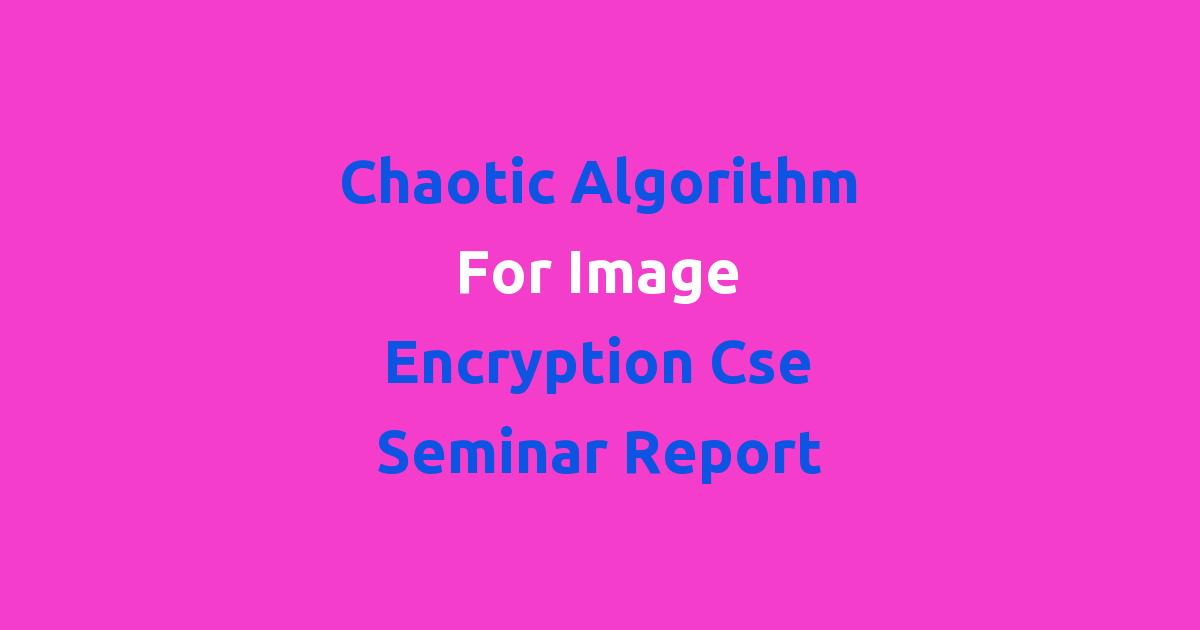An algorithm for encrypting images discussed in a seminar report on computer science and engineering.
Chaotic Algorithm for Image Encryption CSE Seminar Report
Introduction
Image encryption is a crucial aspect of cybersecurity in today’s digital world. With the increasing reliance on digital images for communication and storage purposes, it is essential to protect these images from unauthorized access. Chaotic algorithms have emerged as a promising solution for image encryption due to their ability to generate complex and unpredictable patterns. In this seminar report, we will explore the use of chaotic algorithms for image encryption and discuss their effectiveness in securing digital images.
Problem Statement
Traditional encryption techniques are no longer sufficient to protect digital images from sophisticated cyber attacks. These techniques are vulnerable to brute force attacks, key guessing, and other methods used by hackers to access encrypted data. As a result, there is a need for a more robust and secure image encryption method that can withstand these attacks.
Existing System
The existing image encryption systems primarily rely on symmetric or asymmetric encryption algorithms such as AES, DES, and RSA. While these algorithms are widely used and well-established, they have certain limitations when it comes to image encryption. Symmetric algorithms require the sharing of a secret key between the sender and receiver, which can be challenging to manage for large-scale image encryption. Asymmetric algorithms, on the other hand, are computationally intensive and may not be suitable for real-time image encryption.
Disadvantages
The disadvantages of the existing image encryption systems include vulnerability to attacks, limited scalability, and high computational overhead. Symmetric encryption algorithms are susceptible to brute force attacks if the secret key is compromised. Asymmetric encryption algorithms are computationally intensive and may not be practical for real-time image encryption. Furthermore, these algorithms may not provide the level of security required to protect digital images from advanced cyber threats.
Proposed System
The proposed system aims to overcome the limitations of the existing image encryption systems by leveraging chaotic algorithms for image encryption. Chaotic algorithms are characterized by their sensitive dependence on initial conditions, which results in the generation of complex and unpredictable patterns. These algorithms are highly resistant to attacks and can provide a high level of security for digital images.
Advantages
The advantages of the proposed system include enhanced security, scalability, and efficiency. Chaotic algorithms are capable of generating complex patterns that are difficult to decipher, making them highly secure for image encryption. These algorithms do not require the sharing of a secret key between the sender and receiver, simplifying the encryption process for large-scale image encryption. Furthermore, chaotic algorithms are computationally efficient and can be implemented in real-time image encryption applications.
Features
The key features of the proposed system include:
– Chaotic algorithm-based encryption: The system utilizes chaotic algorithms to generate encryption keys for securing digital images.
– Real-time encryption: The system is capable of encrypting images in real-time, making it suitable for time-sensitive applications.
– Scalability: The system can scale to accommodate large volumes of image data without compromising security.
– Robust security: The system provides a high level of security against cyber attacks, ensuring the confidentiality and integrity of encrypted images.
Conclusion
In conclusion, chaotic algorithms offer a promising solution for image encryption in the field of cybersecurity. These algorithms provide enhanced security, scalability, and efficiency compared to traditional encryption techniques. The proposed system leverages chaotic algorithms to encrypt digital images securely and efficiently, making it suitable for a wide range of applications. By adopting chaotic algorithms for image encryption, organizations can protect their digital images from advanced cyber threats and ensure the confidentiality of sensitive information.

